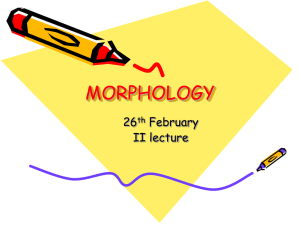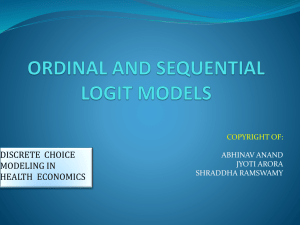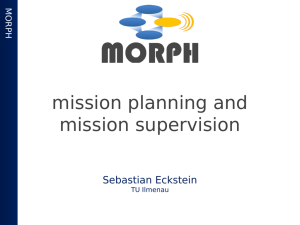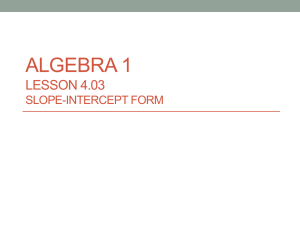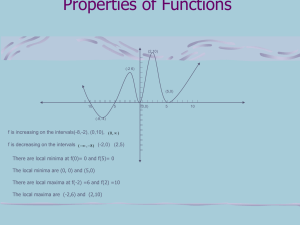mat207 Case Study 21.1.2
advertisement
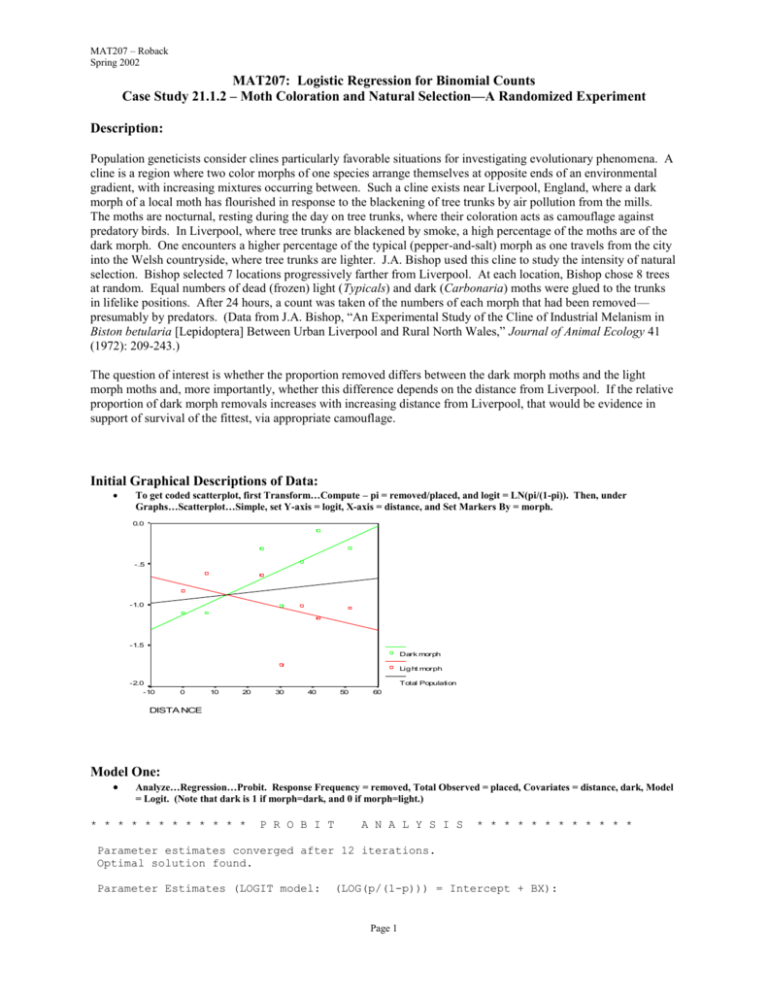
MAT207 – Roback Spring 2002 MAT207: Logistic Regression for Binomial Counts Case Study 21.1.2 – Moth Coloration and Natural Selection—A Randomized Experiment Description: Population geneticists consider clines particularly favorable situations for investigating evolutionary phenomena. A cline is a region where two color morphs of one species arrange themselves at opposite ends of an environmental gradient, with increasing mixtures occurring between. Such a cline exists near Liverpool, England, where a dark morph of a local moth has flourished in response to the blackening of tree trunks by air pollution from the mills. The moths are nocturnal, resting during the day on tree trunks, where their coloration acts as camouflage against predatory birds. In Liverpool, where tree trunks are blackened by smoke, a high percentage of the moths are of the dark morph. One encounters a higher percentage of the typical (pepper-and-salt) morph as one travels from the city into the Welsh countryside, where tree trunks are lighter. J.A. Bishop used this cline to study the intensity of natural selection. Bishop selected 7 locations progressively farther from Liverpool. At each location, Bishop chose 8 trees at random. Equal numbers of dead (frozen) light (Typicals) and dark (Carbonaria) moths were glued to the trunks in lifelike positions. After 24 hours, a count was taken of the numbers of each morph that had been removed— presumably by predators. (Data from J.A. Bishop, “An Experimental Study of the Cline of Industrial Melanism in Biston betularia [Lepidoptera] Between Urban Liverpool and Rural North Wales,” Journal of Animal Ecology 41 (1972): 209-243.) The question of interest is whether the proportion removed differs between the dark morph moths and the light morph moths and, more importantly, whether this difference depends on the distance from Liverpool. If the relative proportion of dark morph removals increases with increasing distance from Liverpool, that would be evidence in support of survival of the fittest, via appropriate camouflage. Initial Graphical Descriptions of Data: To get coded scatterplot, first Transform…Compute – pi = removed/placed, and logit = LN(pi/(1-pi)). Then, under Graphs…Scatterplot…Simple, set Y-axis = logit, X-axis = distance, and Set Markers By = morph. 0.0 -.5 -1.0 -1.5 LOGIT Dark morph Lig ht morph -2.0 Total Population -10 0 10 20 30 40 50 60 DISTA NCE Model One: Analyze…Regression…Probit. Response Frequency = removed, Total Observed = placed, Covariates = distance, dark, Model = Logit. (Note that dark is 1 if morph=dark, and 0 if morph=light.) * * * * * * * * * * * * P R O B I T A N A L Y S I S * * * * * * * * * * * * Parameter estimates converged after 12 iterations. Optimal solution found. Parameter Estimates (LOGIT model: (LOG(p/(1-p))) = Intercept + BX): Page 1 MAT207 – Roback Spring 2002 Regression Coeff. DISTANCE DARK Pearson Standard Error Coeff./S.E. .00531 .40405 .00400 .13938 1.32792 2.89895 Intercept Standard Error Intercept/S.E. -1.13674 .15676 -7.25156 Goodness-of-Fit Chi Square = 24.798 DF = 11 P = .010 Since Goodness-of-Fit Chi square is significant, a heterogeneity factor is used in the calculation of confidence limits. Observed and Expected Frequencies DISTANCE Number of Subjects Observed Responses Expected Responses Residual Prob .00 .00 7.20 7.20 24.10 24.10 30.20 30.20 36.40 36.40 41.50 41.50 51.20 51.20 56.0 56.0 80.0 80.0 52.0 52.0 60.0 60.0 60.0 60.0 84.0 84.0 92.0 92.0 17.0 14.0 28.0 20.0 18.0 22.0 9.0 16.0 16.0 23.0 20.0 40.0 24.0 39.0 13.603 18.178 20.002 26.644 13.896 18.371 16.418 21.644 16.814 22.101 24.001 31.474 27.266 35.589 3.397 -4.178 7.998 -6.644 4.104 3.629 -7.418 -5.644 -.814 .899 -4.001 8.526 -3.266 3.411 .24292 .32460 .25002 .33305 .26724 .35329 .27363 .36073 .28023 .36836 .28573 .37469 .29636 .38684 Model Two: Analyze…Regression…Probit. Response Frequency = removed, Total Observed = placed, Covariates = distance, dark, drkbydst; Model = Logit. (Note that drkbydst=dark*distance.) * * * * * * * * * * * * P R O B I T A N A L Y S I S * * * * * * * * * * * * Parameter estimates converged after 13 iterations. Optimal solution found. Parameter Estimates (LOGIT model: Regression Coeff. DISTANCE DARK DRKBYDST Pearson (LOG(p/(1-p))) = Intercept + BX): Standard Error Coeff./S.E. -.00929 -.41126 .02779 .00579 .27449 .00809 -1.60439 -1.49826 3.43691 Intercept Standard Error Intercept/S.E. -.71773 .19020 -3.77345 Goodness-of-Fit Chi Square = 12.709 DF = 10 P = .240 Since Goodness-of-Fit Chi square is NOT significant, no heterogeneity factor is used in the calculation of confidence limits. Page 2 MAT207 – Roback Spring 2002 Observed and Expected Frequencies DISTANCE Number of Subjects Observed Responses Expected Responses Residual Prob .00 .00 7.20 7.20 24.10 24.10 30.20 30.20 36.40 36.40 41.50 41.50 51.20 51.20 56.0 56.0 80.0 80.0 52.0 52.0 60.0 60.0 60.0 60.0 84.0 84.0 92.0 92.0 17.0 14.0 28.0 20.0 18.0 22.0 9.0 16.0 16.0 23.0 20.0 40.0 24.0 39.0 18.362 13.683 25.066 21.582 14.591 17.450 16.158 21.671 15.487 23.283 20.929 34.497 21.407 41.833 -1.362 .317 2.934 -1.582 3.409 4.550 -7.158 -5.671 .513 -.283 -.929 5.503 2.593 -2.833 .32789 .24435 .31333 .26977 .28059 .33557 .26930 .36119 .25812 .38805 .24915 .41068 .23268 .45471 Model Three: Analyze…Regression…Probit. Response Frequency = removed, Total Observed = placed, Factor = loca_int, Covariates = dark, drkbydst; Model = Logit. (Note that loca_int takes on values 1-7 corresponding to the 7 sites.) * * * * * * * * * * * * LOCA_INT Level 1 2 3 4 5 6 7 P R O B I T N of Cases 2 2 2 2 2 2 2 A N A L Y S I S * * * * * * * * * * * * Label 1 2 3 4 5 6 7 Parameter estimates converged after 18 iterations. Optimal solution found. Parameter Estimates (LOGIT model: Regression Coeff. DARK DRKBYDST Pearson (LOG(p/(1-p))) = Intercept + BX): Standard Error Coeff./S.E. -.40546 .02774 .27519 .00810 -1.47341 3.42574 Intercept Standard Error Intercept/S.E. LOCA_INT -.76692 -.74655 -.60353 -1.56475 -1.04906 -.98067 -1.20122 .24621 .20418 .21575 .23933 .21431 .18966 .20768 -3.11485 -3.65636 -2.79736 -6.53806 -4.89501 -5.17060 -5.78397 1 2 3 4 5 6 7 Goodness-of-Fit Chi Square = 2.867 DF = 5 P = .720 Since Goodness-of-Fit Chi square is NOT significant, no heterogeneity factor is used in the calculation of confidence limits. Page 3 MAT207 – Roback Spring 2002 Observed and Expected Frequencies LOCA_INT DARK Number of Subjects Observed Responses Expected Responses Residual Prob 1 1 .00 1.00 56.0 56.0 17.0 14.0 17.760 13.240 -.760 .760 .31715 .23642 2 2 .00 1.00 80.0 80.0 28.0 20.0 25.726 22.274 2.274 -2.274 .32157 .27843 3 3 .00 1.00 52.0 52.0 18.0 22.0 18.384 21.616 -.384 .384 .35354 .41569 4 4 .00 1.00 60.0 60.0 9.0 16.0 10.378 14.622 -1.378 1.378 .17297 .24370 5 5 .00 1.00 60.0 60.0 16.0 23.0 15.564 23.436 .436 -.436 .25941 .39059 6 6 .00 1.00 84.0 84.0 20.0 40.0 22.912 37.088 -2.912 2.912 .27276 .44153 7 7 .00 1.00 92.0 92.0 24.0 39.0 21.276 41.724 2.724 -2.724 .23126 .45352 Page 4
